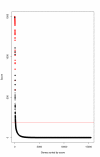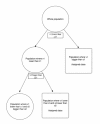Genome-wide identification of new Wnt/beta-catenin target genes in the human genome using CART method
- PMID: 20515496
- PMCID: PMC2996972
- DOI: 10.1186/1471-2164-11-348
Genome-wide identification of new Wnt/beta-catenin target genes in the human genome using CART method
Abstract
Background: The importance of in silico predictions for understanding cellular processes is now widely accepted, and a variety of algorithms useful for studying different biological features have been designed. In particular, the prediction of cis regulatory modules in non-coding human genome regions represents a major challenge for understanding gene regulation in several diseases. Recently, studies of the Wnt signaling pathway revealed a connection with neurodegenerative diseases such as Alzheimer's. In this article, we construct a classification tool that uses the transcription factor binding site motifs composition of some gene promoters to identify new Wnt/beta-catenin pathway target genes potentially involved in brain diseases.
Results: In this study, we propose 89 new Wnt/beta-catenin pathway target genes predicted in silico by using a method based on multiple Classification and Regression Tree (CART) analysis. We used as decision variables the presence of transcription factor binding site motifs in the upstream region of each gene. This prediction was validated by RT-qPCR in a sample of 9 genes. As expected, LEF1, a member of the T-cell factor/lymphoid enhancer-binding factor family (TCF/LEF1), was relevant for the classification algorithm and, remarkably, other factors related directly or indirectly to the inflammatory response and amyloidogenic processes also appeared to be relevant for the classification. Among the 89 new Wnt/beta-catenin pathway targets, we found a group expressed in brain tissue that could be involved in diverse responses to neurodegenerative diseases, like Alzheimer's disease (AD). These genes represent new candidates to protect cells against amyloid beta toxicity, in agreement with the proposed neuroprotective role of the Wnt signaling pathway.
Conclusions: Our multiple CART strategy proved to be an effective tool to identify new Wnt/beta-catenin pathway targets based on the study of their regulatory regions in the human genome. In particular, several of these genes represent a new group of transcriptional dependent targets of the canonical Wnt pathway. The functions of these genes indicate that they are involved in pathophysiology related to Alzheimer's disease or other brain disorders.
Figures




Similar articles
-
Novel β-catenin target genes identified in thalamic neurons encode modulators of neuronal excitability.BMC Genomics. 2012 Nov 17;13:635. doi: 10.1186/1471-2164-13-635. BMC Genomics. 2012. PMID: 23157480 Free PMC article.
-
Activation of the Wnt/β-catenin pathway represses the transcription of the β-amyloid precursor protein cleaving enzyme (BACE1) via binding of T-cell factor-4 to BACE1 promoter.FASEB J. 2015 Feb;29(2):623-35. doi: 10.1096/fj.14-253211. Epub 2014 Nov 10. FASEB J. 2015. PMID: 25384422
-
Tissue- and stage-specific Wnt target gene expression is controlled subsequent to β-catenin recruitment to cis-regulatory modules.Development. 2016 Jun 1;143(11):1914-25. doi: 10.1242/dev.131664. Epub 2016 Apr 11. Development. 2016. PMID: 27068107 Free PMC article.
-
Interaction of nuclear receptors with the Wnt/beta-catenin/Tcf signaling axis: Wnt you like to know?Endocr Rev. 2005 Dec;26(7):898-915. doi: 10.1210/er.2003-0034. Epub 2005 Aug 26. Endocr Rev. 2005. PMID: 16126938 Review.
-
Wnt/β-Catenin Signaling Pathway Governs a Full Program for Dopaminergic Neuron Survival, Neurorescue and Regeneration in the MPTP Mouse Model of Parkinson's Disease.Int J Mol Sci. 2018 Nov 24;19(12):3743. doi: 10.3390/ijms19123743. Int J Mol Sci. 2018. PMID: 30477246 Free PMC article. Review.
Cited by
-
S-nitrosoglutathione reductase (GSNOR) deficiency accelerates cardiomyocyte differentiation of induced pluripotent stem cells.J Cardiovasc Aging. 2021;1:13. doi: 10.20517/jca.2021.19. Epub 2021 Sep 7. J Cardiovasc Aging. 2021. PMID: 34790975 Free PMC article.
-
Altered WNT Signaling in Human Induced Pluripotent Stem Cell Neural Progenitor Cells Derived from Four Schizophrenia Patients.Biol Psychiatry. 2015 Sep 15;78(6):e29-34. doi: 10.1016/j.biopsych.2014.12.028. Epub 2015 Jan 30. Biol Psychiatry. 2015. PMID: 25708228 Free PMC article. No abstract available.
-
Combination effects of AHR agonists and Wnt/β-catenin modulators in zebrafish embryos: Implications for physiological and toxicological AHR functions.Toxicol Appl Pharmacol. 2015 Apr 15;284(2):163-79. doi: 10.1016/j.taap.2015.02.014. Epub 2015 Feb 21. Toxicol Appl Pharmacol. 2015. PMID: 25711857 Free PMC article.
-
Improved erythroid differentiation of multiple human pluripotent stem cell lines in microcarrier culture by modulation of Wnt/β-Catenin signaling.Haematologica. 2018 Jul;103(7):e279-e283. doi: 10.3324/haematol.2017.180919. Epub 2018 Mar 8. Haematologica. 2018. PMID: 29519863 Free PMC article. No abstract available.
-
Dramatic dysbalancing of the Wnt pathway in breast cancers.Sci Rep. 2018 May 9;8(1):7329. doi: 10.1038/s41598-018-25672-6. Sci Rep. 2018. PMID: 29743726 Free PMC article.
References
Publication types
MeSH terms
Substances
LinkOut - more resources
Full Text Sources
Other Literature Sources
Research Materials

